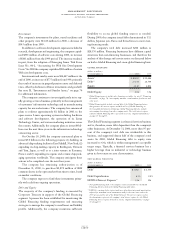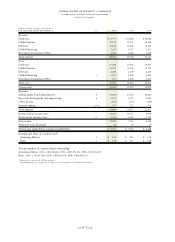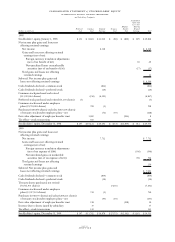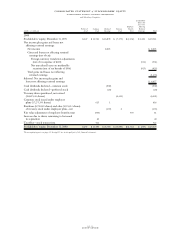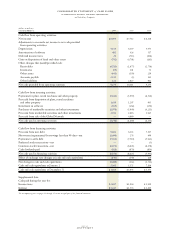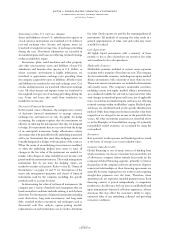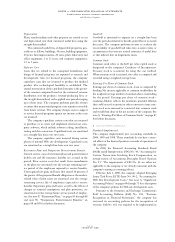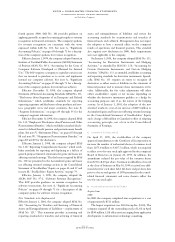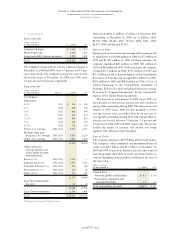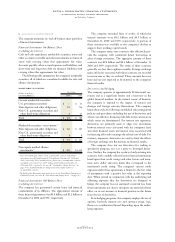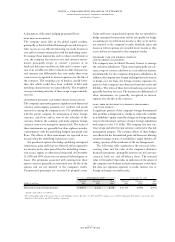IBM 2000 Annual Report Download - page 71
Download and view the complete annual report
Please find page 71 of the 2000 IBM annual report below. You can navigate through the pages in the report by either clicking on the pages listed below, or by using the keyword search tool below to find specific information within the annual report.
ASIGNIFICANT ACCOUNTING POLICIES
Principles of Consolidation
The consolidated financial statements include the accounts
of International Business Machines Corporation and its con-
trolled subsidiary companies, which in general are majority
owned. Investments in business entities in which the company
does not have control, but has the ability to exercise signifi-
cant influence over operating and financial policies (generally
20-50 percent ownership), are accounted for by the equity
method. Other investments are accounted for by the cost
method. The accounting policy for other investments in secu-
rities is described on page 70 within Marketable Securities.
Use of Estimates
The preparation of financial statements in conformity with
generally accepted accounting principles requires management
to make estimates and assumptions that affect the amounts
that are reported in the consolidated financial statements
and accompanying disclosures. Although these estimates are
based on management’s best knowledge of current events
and actions that the company may undertake in the future,
actual results may be different from the estimates.
Revenue
The company recognizes revenue when it is realized or real-
izable and earned. The company considers revenue realized
or realizable and earned when it has persuasive evidence of
an arrangement, the product has been shipped or the services
have been provided to the customer, the sales price is fixed
or determinable and collectibility is reasonably assured. The
company reduces revenue for estimated customer returns. In
addition to the aforementioned general policy, the following
are the specific revenue recognition policies for each major
category of revenue.
HARDWARE
Revenue from hardware sales or sales-type leases is recog-
nized when the product is shipped to the customer and there
are either no unfulfilled company obligations or any obliga-
tions will not affect the customer’s final acceptance of the
arrangement. Any cost of these obligations is accrued when
the corresponding revenue is recognized. Revenue from
rentals and operating leases is recognized monthly as the
fees accrue.
SERVICES
Revenue from time and material service contracts is recog-
nized as the services are provided. Revenue from fixed price
long-term service contracts is recognized over the contract
term based on the percentage of services that are provided
during the period compared with the total estimated services
to be provided over the entire contract. Losses on fixed price
contracts are recognized during the period in which the
loss first becomes apparent. Revenue from maintenance is
recognized over the contractual period or as the services are
performed. Revenue in excess of billings on service contracts
is recorded as unbilled receivables and is included in trade
accounts receivable. Billings in excess of revenue that is rec-
ognized on service contracts are recorded as deferred income
until the aforementioned revenue recognition criteria are met.
SOFTWARE
Revenue from delivered elements of one-time charge
licensed software is recognized at the inception of the license
term, provided the company has vendor-specific objective
evidence of the fair value of each undelivered element.
Revenue is deferred for undelivered elements. Revenue is
also deferred for the entire arrangement if vendor-specific
objective evidence does not exist for each undelivered contract
element. Examples of undelivered elements in which the
timing of delivery is uncertain include contractual elements
that give customers rights to any future upgrades at no addi-
tional charge, future maintenance that is provided within
the overall price, and standard performance and function
guarantees. The revenue that is deferred for any contract
element is recognized when all of the revenue recognition
criteria have been met for that element, which typically
occurs within two to three years. Revenue from monthly
software licenses is recognized on a subscription basis.
FINANCING
Revenue from financing is recognized at level rates of return
over the term of the lease or receivable.
Selling, General and Administrative Expense
Selling, general and administrative expense is charged to
income as incurred. Expenses of promoting and selling
products are classified as selling expense and include such
items as advertising, sales commissions and travel. General
and administrative expense includes such items as officers’
salaries, office supplies, taxes, insurance and office rental. In
addition, general and administrative expense includes recur-
ring other operating items such as gains and losses from sales
and disposals of assets other than securities, licensing of
intellectual property, amortization of goodwill and currency
exchange gains/losses.
Income Taxes
Income tax expense is based on reported income before
income taxes. Deferred income taxes reflect the effect of
temporary differences between assets and liabilities that are
recognized for financial reporting purposes and the amounts
that are recognized for income tax purposes. These deferred
taxes are measured by applying currently enacted tax laws.
Valuation allowances are recognized to reduce the deferred
tax assets to the amount that is more likely than not to be
realized. In assessing the likelihood of realization, manage-
ment considers estimates of future taxable income.
notes to consolidated financial statements
international business machines corporation
and Subsidiary Companies
page no.
sixty-nine



